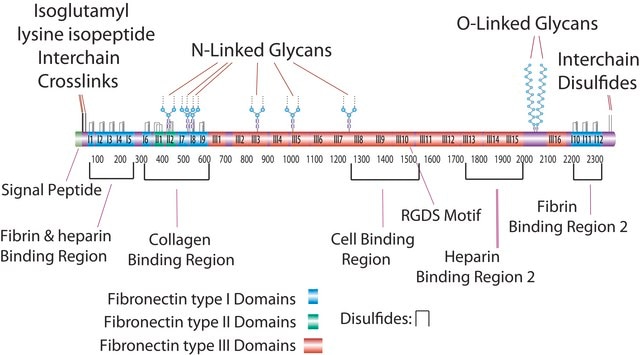F1903
Fibronectin 40 kDa α Chymotryptic Fragment (Heparin-binding region), Human purified
About This Item
Recommended Products
biological source
human
Quality Level
form
lyophilized
mol wt
40 kDa
manufacturer/tradename
Chemicon®
concentration
1 mg/mL
technique(s)
cell culture | mammalian: suitable
input
sample type epithelial cells
sample type: human embryonic stem cell(s)
sample type mesenchymal stem cell(s)
sample type hematopoietic stem cell(s)
sample type pancreatic stem cell(s)
sample type induced pluripotent stem cell(s)
sample type neural stem cell(s)
UniProt accession no.
shipped in
dry ice
storage temp.
−20°C
Gene Information
human ... FN1(2335)
Related Categories
General description
Human sourced raw material used in the production of this product tested negative for hepatitis B virus, hepatitis C virus (HCV), human immunodeficiency virus type-1 (HIV-1) and type-2 (HIV-2), human T-cell lymphotropic virus (HTLV-1 and HTLV-2) and Treponema pallidum. Handle as if potentially infectious.
Application
Affinity chromatography
Possibly for molecular mapping of fibronectin function
Cell attachment and integrin signaling assays
Optimal working dilutions must be determined by the end user.
Physical form
Storage and Stability
Legal Information
Disclaimer
wgk_germany
WGK 1
Certificates of Analysis (COA)
Search for Certificates of Analysis (COA) by entering the products Lot/Batch Number. Lot and Batch Numbers can be found on a product’s label following the words ‘Lot’ or ‘Batch’.
Already Own This Product?
Find documentation for the products that you have recently purchased in the Document Library.
Articles
Extracellular matrix proteins such as laminin, collagen, and fibronectin can be used as cell attachment substrates in cell culture.
Protocols
Dilute fibronectin to the desired concentration. Optimum conditions for attachment are dependent on cell type and application. The typical coating concentration is 1 – 5 ug/cm2.Fibronectin coating protocol, products, and FAQs at sigmaaldrich.com
Dilute fibronectin to the desired concentration. Optimum conditions for attachment are dependent on cell type and application. The typical coating concentration is 1 – 5 ug/cm2.Fibronectin coating protocol, products, and FAQs.
This page covers the ECM coating protocols developed for four types of ECMs on Millicell®-CM inserts, Collagen Type 1, Fibronectin, Laminin, and Matrigel.
Our team of scientists has experience in all areas of research including Life Science, Material Science, Chemical Synthesis, Chromatography, Analytical and many others.
Contact Technical Service

